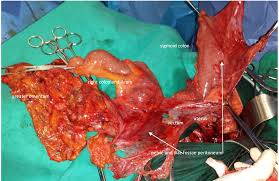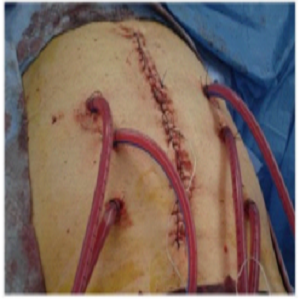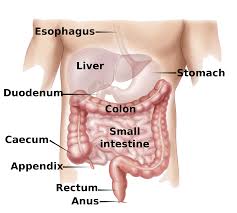Cytoreductive Surgery, Appendix Cancer, Pseudomyxoma & HIPEC
Cytoreductive Surgery and ovary cancer, pseudomyxoma, and HIPEC in Pune - Dr. Snita Sinukuma
HIPEC or hyperthermic intraperitoneal chemotherapy is an innovatory system applied to treat cancers that have originated in or spread to the abdominal cavity, such as appendiceal cancer, pseudomyxoma peritonei, colon cancer, gastric cancer, ovarian cancer, and peritoneal mesothelioma. Best HIPEC specialist in Pune by Dr Snita Sinukumar
The treatment has two primary elements
- Surgical cytoreduction
- HIPEC
Surgical Cytoreduction
This requires removal of the tumor within the peritoneal cavity to no visible residual disease or residual disease less than or equal to 2.5mm. This is termed as complete or near-complete cytoreduction. To achieve this state of complete cytoreduction, multiple extensive surgical resections might need to be performed, such as peritonectomy, multiple bowel, and visceral resections. Best HIPEC specialist in Pune by Dr Snita Sinukumar


HIPEC:
Only after achieving a complete or near-complete cytoreduction can HIPEC be administered. If gross residual disease is left behind HIPEC is not justified. During HIPEC, a special machine heats the fluid and the chemotherapeutic agent to a temperature of 42-44 degrees which is then pumped into the abdominal cavity@of 1ltr/min. Around 4-6 liters of fluid is circulated within the abdominal cavity throughout 60mins, through intrabdominal placed drains. Pseudomyxoma in Pune – Dr. Snita Sinukumar
WHY HIPEC AND WHAT ARE THE ADVANTAGES?
- HIPEC is delivered directly into the abdominal cavity, so it can penetrate the cancer cells and diseased tissue more easily than traditional chemotherapy.
- Heated chemotherapy improves the blood flow in the abdominal cavity, which helps improve the delivery of the medicine to the cancer cells.
- Since treatment is being delivered directly to the cancer site, higher doses of chemotherapy can be used. The rest of your body receives less exposure to chemotherapy, and you’ll experience fewer side-effects.
- You receive HIPEC in a single dose during surgery, as opposed to undergoing multiple treatment sessions with traditional chemotherapy.
- HIPEC is more likely to kill remaining or hard to see cancer cells compared to standard chemotherapy treatment.
WHAT ARE THE RISKS OF CYTOREDUCTIVE SURGERY WITH HIPEC?
- The risks of adverse complications after HIPEC surgery is reported to be 2.2%-20%. The risk of death is only 1%-4%.The following complications may occur
- Bleeding
- Infection
- Formation of blood clots in legs(Deep vein t
- Development of an enterocutaneous fistula or an anastomotic leak
- Reduced oral intake resulting in the need for TPN
- Changes in bowel habits, constipation, or diarrhea, which usually resolves in 10-14 days post-surgery but may take a longer time. Pseudomyxoma in Pune – Dr. Snita Sinukumar
HOW DO I PREPARE MYSELF FOR THIS SURGERY?
Following a discussion with your doctor about the potential benefits of CRS+HIPEC, you will be guided to meet the following specialists, 2-3 weeks before the planned surgery date.
- A nutritionist, who will guide you about dietary changes to enable you to build nutritional reserves before surgery.
- A Physiotherapist, who will instruct and assess pulmonary capacity and reserves and train and teach you exercises (Spirometry) to strengthen your lungs.
- A Physician who will evaluate your general well being and assess your fitness to undergo the surgical procedure.
HOW LONG IS THE HOSPITAL STAY AFTER HIPEC SURGERY?
- Cytoreductive surgery with HIPEC is an involved procedure that lasts an average of 8-14 hours, depending on the extent of the disease.
- Patients typically remain in the hospital for 8-10 days.
- Post-surgery you will be required to stay in the ICU for 24-48 hours.
- From the First Post Operative day onwards, you will be encouraged to move around, stand and walk with the help of support.
- Diet and Oral Food intake will slowly resume from 3rd Postoperative day onwards.

WHAT IS THE HIPEC SURGERY RECOVERY PROCESS?
Following cytoreductive surgery with HIPEC, it is not uncommon for patients to feel fatigued for 2-3 months post-operatively.
- While it is important to rest during this period of recovery, it is also important to get up, move around, and remain as active as possible
- Remaining active will help combat fatigue as well as prevent possible complications of the surgery, such as blood clots forming in the legs and pneumonia. Treatment on pseudomyxoma in Pune – Dr. Snita Sinukumar
IS NUTRITION IMPORTANT DURING RECOVERY?
- Nutrition plays a significant role in maintaining health and wound healing
- A nutritionist will evaluate your nutritional status requirements after surgery to ensure the caloric needs are being met.
- A diet chart will be provided to help meet nutrition goals. Treatment on Pseudomyxoma in Pune – Dr. Snita Sinukumar
WHAT IS THE FOLLOW-UP PROCESS?
- Patients should expect to have a follow-up appointment approximately7-10 days after hospital discharge.
- During this visit, patients will also see the dietitian evaluate their nutritional status and create an individualized patient care plan.
- The suture removal and any wound issues will also be addressed during this visit.
- Additionally, follow up lab work for tumor markers CEA, CA19-9, and CA125 would be drawn every 3 months for the first 2 years postoperatively, then every 6 months for years 3-5. CT scans should be performed every 6 months for the first 2 years postoperatively, then annually for years 3-5.
